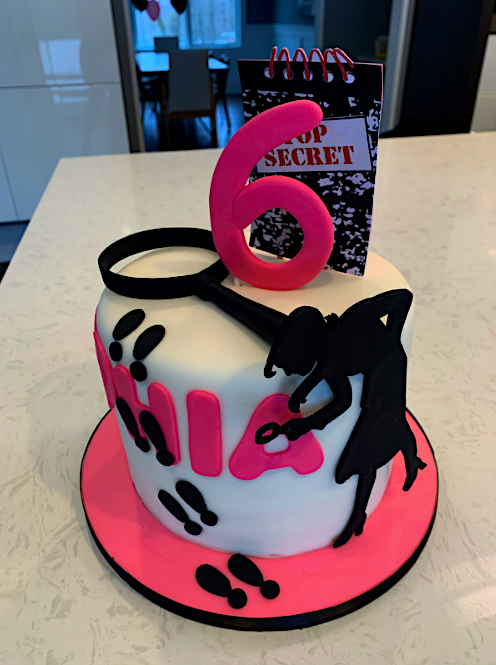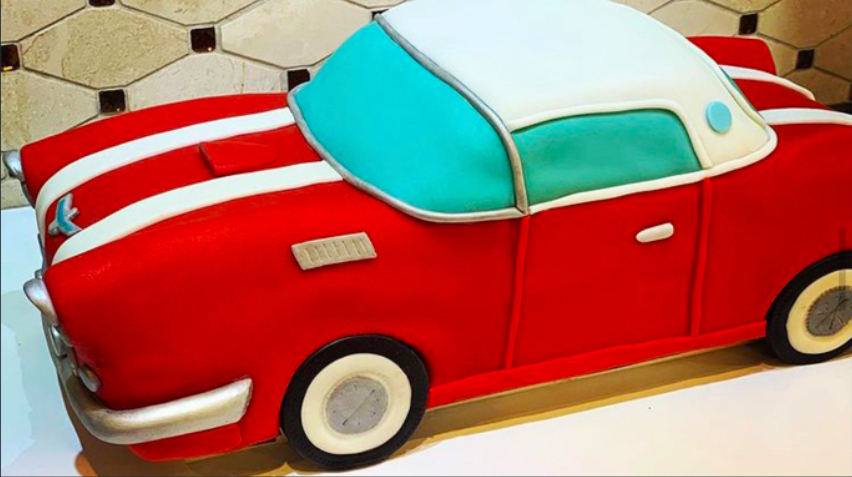
The art-you-can-eat phenomenon has taken the baking world by storm. Internet patrons gawk at videos of coffee cups, snack bags and toilet paper being sliced into neat, layered portions of dessert. This combination of culinary practice and optical-illusionary seems exclusive to only the most seasoned baking artists, and it’s almost a shame that their edible statement pieces are cut and consumed.
But for self-taught cake artist Sophie Karabatsos, the cutting is the best part.
“That’s my whole satisfaction — to take a knife, stab into that cake, and feed you. Eat it and enjoy it, that’s the whole point!” the high school journalism instructor and self-taught professional baker said, over the cacophony of her electric mixer.
“That’s my whole satisfaction — to take a knife, stab into that cake, and feed you. Eat it and enjoy it, that’s the whole point!” –Sophie Karabatsos
Karabatsos teaches in New Jersey’s Fort Lee School District. When her last class of the day ends at 1:15 p.m. — and even during lunch breaks — she rushes home to mold fondant, or to wash a heaping pile of mixing bowls and cake pans, in preparation for her next order.
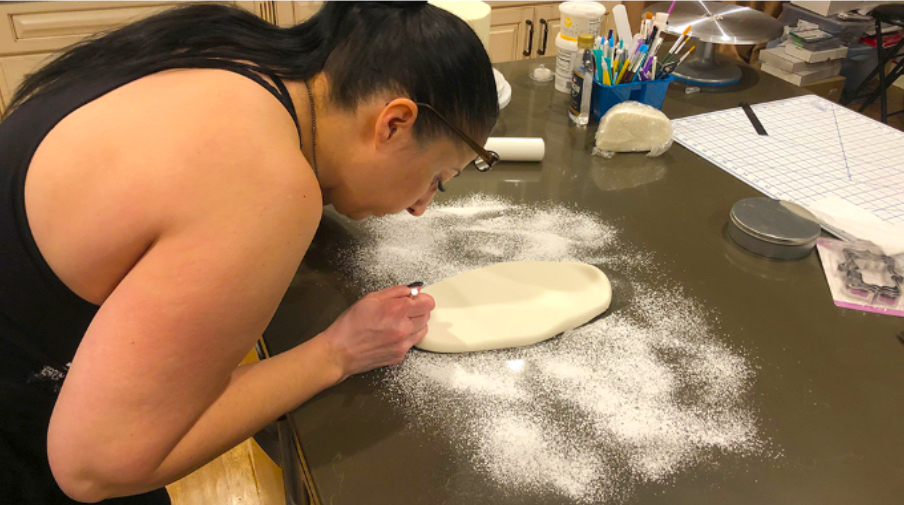
Now she’s putting together a Nancy Drew-inspired cake for an old Greek school classmate’s daughter.
Karabatsos’ workstation is a large kitchen island in a far corner beyond her living room. It immediately draws attention, as the only area of the house fully illuminated, buzzing with baking activity. Karabatsos keeps her hair slicked back into a tight ponytail as she dances around the kitchen, pulling from a fully-stocked cabinet of dry and wet ingredients that tower toward the ceiling. Her front door is left unlocked for family and friends to pull up one of the chairs around the island and watch, as she carves a ‘69 Thunderbird from vanilla cake.
“I started in the summer of 2019,” Karabatsos recounted, spooning together a chocolate-and-coffee mixture. “I baked for my friend’s birthday every year, but that time I wanted to put together a more professional-looking cake. I started watching YouTube videos, but I didn’t have the tools the bakers were using in the demonstrations.”
So Karabatsos improvised. She cut the tip of a Ziploc bag to fashion a homemade piping cone, and used a flat meat knife as a makeshift spatula to smooth out her buttercream.
As more birthdays for coworkers, family and trainers came up in the following months, Karabatsos slowly filled her calendar with cakes to make for the occasions.
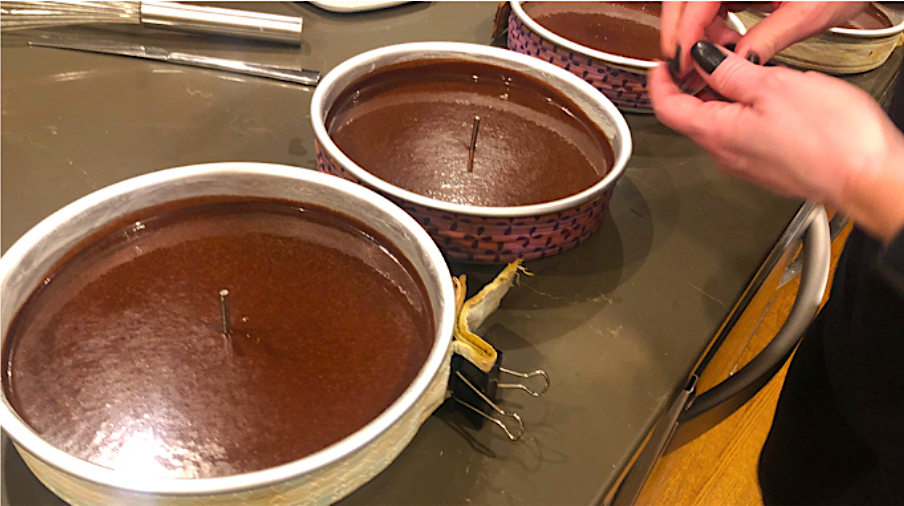
A Hobby Becomes a Business
“Little by little, I was baking cakes regularly,” she said, as she paused her story to whisper ingredients and measurements under her breath, seamlessly multi-tasking and flowing back into conversation like the sugar she poured into her mixing bowls. “But I couldn’t find it in my heart to charge people until I was confident in my skills. So I started practicing and watching more videos until I got where I am today.”
That includes a new brand, NJgirlgotcake, which she promotes on Instagram.
Karabatsos invested in cake-sculpting kits to bring her baking to the next level. From turntables and spatulas to molding brushes and food coloring tubes, her kitchen became a fully-equipped tour de force for professional cakes.
She takes baking inspiration from world-renowned pastry chef Serdar Yenner and The Preppy Kitchen ’s John Kanell during her “YouTube University” lessons, as she calls them.
Karabatsos inserted tiny metal heat conductors into the middle of her cake pans to make perfectly level layers.

“My sister-in-law eventually made me put up an Instagram for the cakes I was doing,” she said. “So I posted a couple and people were direct messaging me asking for personalized cake orders, who insisted on paying for my work.”
One customer was Kristen Rodriguez, a coworker at school. When she discovered Karabatsos was building up a cake following, she wanted in on the sweet action.
“I saw her posts on her social media accounts; I was really impressed with her skill and talent,” Rodriguez said. “Her attention to detail is excellent.”
While Karabatsos’ small social media business grew steadily, it stagnated due to the COVID-19 pandemic. She was unable to bake during lockdown, as parties and other large gatherings were postponed indefinitely. Her four cakes scheduled for March 2020 were all canceled.
“I couldn’t find flour or baking powder anywhere — so I couldn’t bake,” she recalled. “Even if I wanted to, just to practice. The shelves were empty and stores were closing one by one. Luckily, I had a full-time job to survive through the pandemic. Cake-making was just a perk. I didn’t turn down whoever called, because I wasn’t busy, and was looking for new orders.”
By the end of July 2020, when parties of reduced size were permitted, Karabatsos found customers scheduling cakes for the end of the summer into the fall. From around five orders in November to three to four cakes every week in February 2021, Karabatsos has seen her following grow.
She now delivers her confectionary treats to customers around New Jersey and New York.
“Mom would have a bunch of these cake pans and flour all over the kitchen table,” said Achilles Barakos, Karabatsos’s son. “I help her out when she needs me to bring cakes down to her car.”
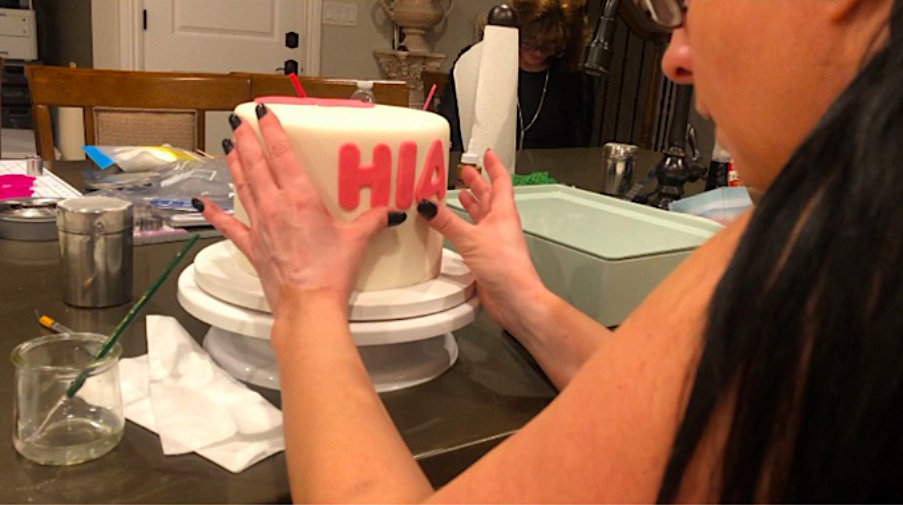
Karabatsos often enlists her son’s help to streamline the cake baking-and-decorating process, when he’s not in virtual classes. But help is hard to come by, with cake orders piling on every week. While Karabatsos is self-taught, she is also self-sustaining — it’s hard to find assistants willing to work around her eclectic schedule.
“I don’t have regular baker’s hours. I have to work really late at night because during the day I have a house, a kid, and a full-time job to take care of. At midnight I get a solid two to three hours of work done without having to be at anyone’s beck and call. But therein lies the issue — who wants to work on cakes until 3 a.m.?” she asked rhetorically, while rolling out a sheet of white fondant.
“I have no room or time to make mistakes, so I’ve had to learn how to plan ahead. I can’t be baking and decorating at the same time either, because I need to save space on my countertop, so I freeze some of my cakes ahead of time,” she added, motioning to the cake pans in the oven. “I stick with similar recipes that help my cakes stay moist longer. These processes have made me more resourceful with my time and in cutting costs.”
Journalism instruction and cake-decorating are not the only skills that grace Karabatsos’s impressive resume. She’s also a licensed cosmetologist and hair stylist, on top of making her own beauty products and candles from scratch. Some of these skills have carried over into her baking profession — she knows how colors interact to become the perfect shade of blue or pink icing, which saves her the expense of food dye tubes.
Karabatsos also cuts cake boards out of cardboard boxes she receives with Amazon orders, glues them together, and wraps them in baker’s foil. That allows her to custom size the boards according to her cakes, instead of buying new ones for every order. She’ll make molds, create cake toppers, and even make fondant and buttercream from scratch. For this weekend’s order, she printed Nancy Drew’s silhouette, and used a precision knife to cut the character’s shape into black fondant.
“I work hard and put handmade effort into my cakes, but I still feel bad charging somebody $800 for it,” Karabatsos admitted. “I’ll work with them if they’re on a budget, and charge a reasonable amount. But I’m competitive with bakeries. You want my cakes, you like my style, this is what you get. It’s from scratch, and my workstation is totally sterile. I don’t use any imitation flavors, so the cakes are delicious. That’s the bottom line.”
Karabatsos’ cakes start at a flat fee of $200 and increase with the intricacy of the cake. She adds approximately $50 for every tier on the dessert, but in her opinion, it’s a low figure for the amount of time and effort it takes to complete a cake.
“I think her professionalism and creativity are both excellent,” Rodriguez said. “Her price point should match her hard work.”
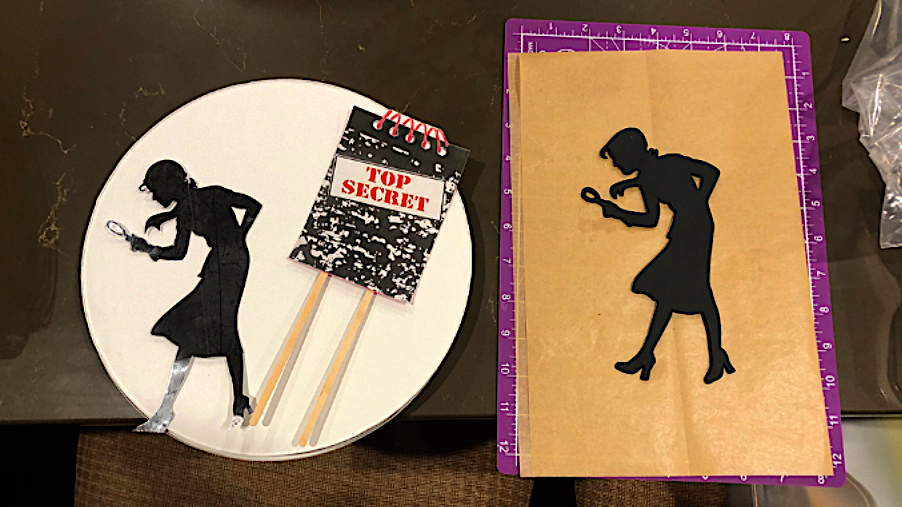
Karabatsos is looking to improve her skills at a pastry school. Her boyfriend, Billy Tsakiridis, is helping her research schools around his home in Chicago, where she plans to visit him over the summer.
“There’s a Wilton school of cake decorating in Chicago, 20 minutes away from me,” said Tsakiridis. “Sophie and I were looking into classes for her before the pandemic. She was going to register in February, [but] as far as we can tell, they’re not reopening anytime soon.”
No matter how you slice it, cake artistry is no easy-going business venture, according to Karabatsos. But at the end of the day, it doesn’t feel like work to her. She enjoys the challenge of a new cake, and is not one to back down from a request. She expects her “NJgirlgotcake” brand to thrive.
“I live and learn through trial and error,” she said. “It’s not just who you watch, it’s what you know. I’ve had cakes cave in on themselves or totally deflate, then I have to learn what I did wrong and teach myself the process. It’s tiring, don’t get me wrong — but I’m not tired. This is kind of like my own personal therapy. I do it because I love it. And because I’m up for anything. I’ll make vegan cakes, shoe cakes, car cakes — as long as it’s within my skill set.”
